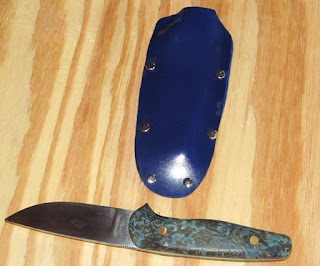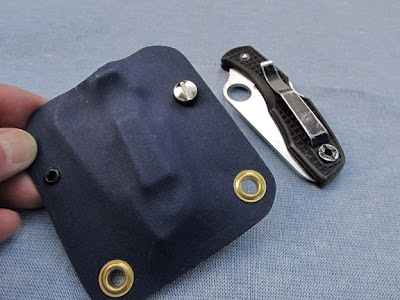I’ve started fooling around with Kydex again. I bought some thicker Kydex at the Blade Show
and made my first knife sheath out of it.
I’ve owned an original DPX HEST designed by Robert Young
Pelton for several years. I like the
knife. It’s a nice size fixed blade
knife: a three-inch carbon steel blade with a four-inch handle. The knife has a built-in bottle opener and
pry bar as well as a small compartment in the handle for survival gear, like
folded twenties or fish hooks. Hey, you
survive your way and I'll survive my way.
 |
| DPX HEST Original sheath. Laughing skull in ball cap is Pelton's trademark. |
The original sheath doesn't have a belt loop. What it has is paracord you use to lash the
sheath to your belt. I was never
comfortable with that. It’s better than
simply slipping it in your pocket,
 |
| Reverse side of knife and sheath. The washer is to undo the screws in the handle. Clever, huh? |
but it always seemed like an easy way to
lose the knife. Maybe that was the Pelton’s
idea.
In the fictional world of Matt Helm, Matt explains to the
readers that most undercover agents don’t carry a sidearm in a holster. Why?
Because you can ditch a gun fast enough, but it might be a little hard
explaining why someone claiming to be a harmless tourist is wearing an empty
holster.
Maybe the same thing applies to this knife. Imagine you’re traveling through areas of the
world where every other mile another thug claims to be the Supreme Warlord and
National President-Elect-for-Life and he has no use for the papers and visas
you’re carrying. If you have to, slip
the paracord loose and the knife falls away from you and it becomes easier to
convince this or the next warlord you are completely harmless. No difficult sheath to explain.
Still, I need to hang on to my knife a little longer, so I
got out the Kydex and spent a few hours re-learning how to do it. It’s not perfect, far from it.
 |
| I got some thicker Kydex and started to work with it. I just got all black Chicago screws that need to be cut to length and then I'll replace the bright aluminum screws. |
The belt loop fits an impossibly thick
belt. I've got to get a thinner form. Most of my rivets, grommets and Chicago
screws are too short. I just squeaked by
with what I have. The 0.1 inch thick
Kydex has a larger radius of bending as compared to my thin blue stuff, so most
of my forms don’t work. It’s also a lot
stiffer, so most of the methods I use to lock a knife in a sheath don’t work as
well.
 |
| The thick kydex bends differently and I need a thinner form to shape my belt loops. |
Still, I’m happy with the results. The set of French curves I bought last year
really helps in setting out the cut and grind lines as does my band saw and the
new-to-me belt sander. I’ll continue to
make sheaths. I’ve got a sweet little South African dagger that needs a sheath
so I can carry it.



